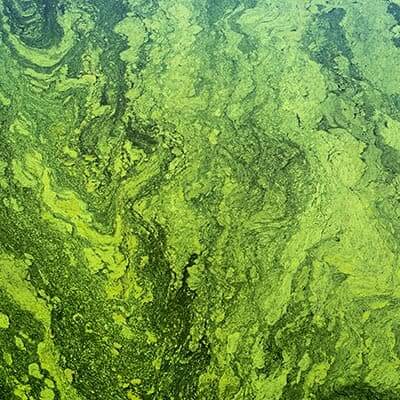Worried about toxic or harmful algae blooms? With all the talk in the news you may be on edge. Let's first assure you that algae blooms are a normal part of a pond ecosystem and not all algae blooms contain harmful toxins.
The algae blooms making headlines are from a type of cyanobacteria. Though rare in well kept waters, some species of blue-green algae (cyanobacteria) can become toxic and bloom rapidly during warm weather when ideal conditions occur. Most often toxic blooms occur due to an oversupply of nutrients such as nitrogen and phosphorus and are most common in waterbodies that receive runoff containing fertilizers, animal waste and septic or sewage water.
What warning signs should you look out for?
These blooms are often described as bright green in color and looking like spilled paint, but can be found in a variety of colors as globs or even as a foamy scum. Generally these mats or films are thick and spread rapidly.
What can you do to help keep your pond or lake from being affected?
While there is no guarantee your pond or lake will never experience this type of bloom, following PROACTIVE pond maintenance methods will ultimately create a nice, balanced pond you can enjoy year after year. PROACTIVE pond care utilizes tools such as aeration, natural bacteria, and pond dye to reduce your pond's nutrient load and limit sun exposure.
- Reduce Nutrients entering the pond - When at all possible limit the entry of nutrients into the water body that would encourage algal growth such as lawn fertilizers and pesticides, organic waste from surrounding areas, leaf litter.
- Increase Water Movement - A Fountain or Aeration System, that is properly sized and placed will provide dissolved oxygen and increased circulation in a pond's natural ecosystem. The increased oxygen and water movement will provide the best possible environment for beneficial bacteria, improving overall water quality and habitat for fish and wildlife.
- Attack the Muck - While beneficial bacteria exist naturally in just about every aquatic environment, in many cases they cannot keep up with the demand of most ponds and lakes. To compensate for this, bacteria treatments are required. The bacteria that make up MuckAway and PondClear, are cultured from common natural aquatic ecosystems found throughout the world. Using naturally occurring bacteria not only makes them extremely effective at nutrient reduction but safe for the environment, people and wildlife.
- Add Pond Dye - Pond dye not only provides beauty to your pond, it is designed to provide a natural shade to limit the excessive amounts of sunlight your pond receives.
If you'd like to get started with any of the methods listed above we can help by providing you with a pond profile. At no cost or commitment to you, we can help measure your pond, help you properly size an aeration system and put together a PROACTIVE pond management plan for you.
When algae does appear, how do I know if it is toxic?
When in doubt it is best to keep yourself, children and your pets out of water that is stagnant or contains severe amounts of algae. There is no way to know for sure if an algae bloom is toxic just by looking at it. If you suspect your waterbody is showing warning signs of a toxic algae bloom a water quality test can be done by your state. For more information, Michigan's EGLE is a great resource.
